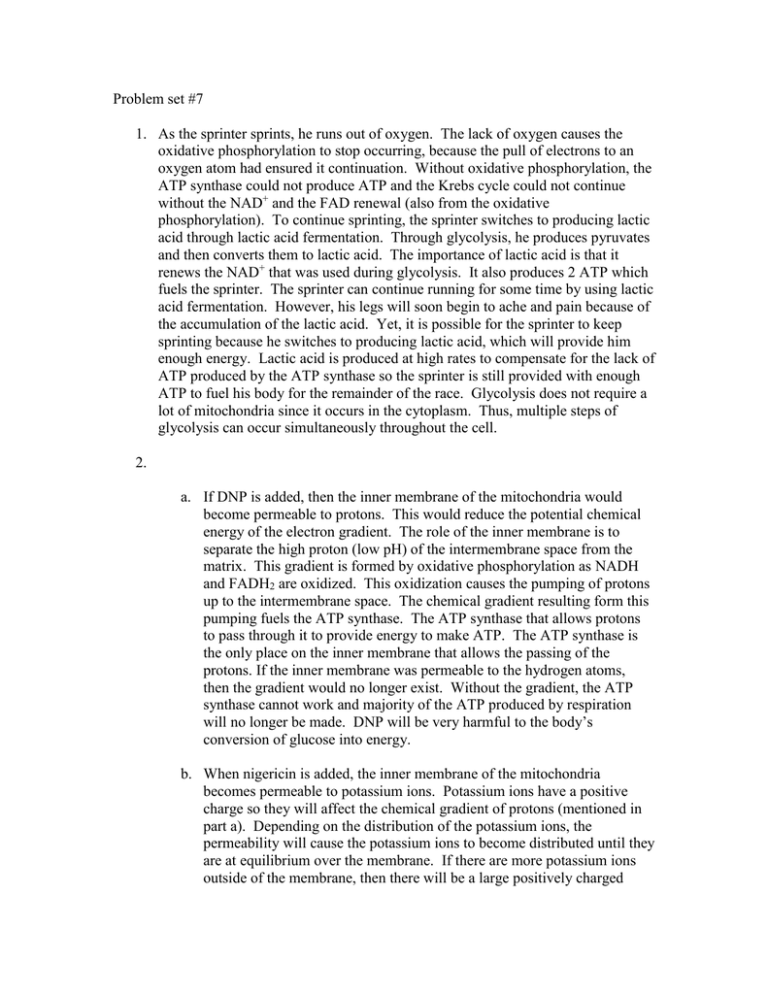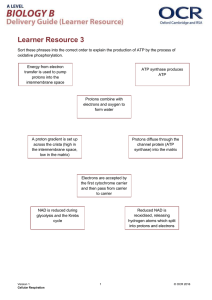Problem set #7
advertisement

Problem set #7 1. As the sprinter sprints, he runs out of oxygen. The lack of oxygen causes the oxidative phosphorylation to stop occurring, because the pull of electrons to an oxygen atom had ensured it continuation. Without oxidative phosphorylation, the ATP synthase could not produce ATP and the Krebs cycle could not continue without the NAD+ and the FAD renewal (also from the oxidative phosphorylation). To continue sprinting, the sprinter switches to producing lactic acid through lactic acid fermentation. Through glycolysis, he produces pyruvates and then converts them to lactic acid. The importance of lactic acid is that it renews the NAD+ that was used during glycolysis. It also produces 2 ATP which fuels the sprinter. The sprinter can continue running for some time by using lactic acid fermentation. However, his legs will soon begin to ache and pain because of the accumulation of the lactic acid. Yet, it is possible for the sprinter to keep sprinting because he switches to producing lactic acid, which will provide him enough energy. Lactic acid is produced at high rates to compensate for the lack of ATP produced by the ATP synthase so the sprinter is still provided with enough ATP to fuel his body for the remainder of the race. Glycolysis does not require a lot of mitochondria since it occurs in the cytoplasm. Thus, multiple steps of glycolysis can occur simultaneously throughout the cell. 2. a. If DNP is added, then the inner membrane of the mitochondria would become permeable to protons. This would reduce the potential chemical energy of the electron gradient. The role of the inner membrane is to separate the high proton (low pH) of the intermembrane space from the matrix. This gradient is formed by oxidative phosphorylation as NADH and FADH2 are oxidized. This oxidization causes the pumping of protons up to the intermembrane space. The chemical gradient resulting form this pumping fuels the ATP synthase. The ATP synthase that allows protons to pass through it to provide energy to make ATP. The ATP synthase is the only place on the inner membrane that allows the passing of the protons. If the inner membrane was permeable to the hydrogen atoms, then the gradient would no longer exist. Without the gradient, the ATP synthase cannot work and majority of the ATP produced by respiration will no longer be made. DNP will be very harmful to the body’s conversion of glucose into energy. b. When nigericin is added, the inner membrane of the mitochondria becomes permeable to potassium ions. Potassium ions have a positive charge so they will affect the chemical gradient of protons (mentioned in part a). Depending on the distribution of the potassium ions, the permeability will cause the potassium ions to become distributed until they are at equilibrium over the membrane. If there are more potassium ions outside of the membrane, then there will be a large positively charged movement into the matrix. It would be the case of potassium being an antiporter, a substance that moves hydrogen ions into the intermembrane space. This will decrease the positive electron gradient, and cause a decrease in ATP production from the ATP synthase, since many electrons do not immediately pass through the synthase. On the other hand, if there are more potassium ions in the matrix, then there will be a large positively charged movement out of the matrix, as the potassium ions travel to the intermembrane space. This will cause a larger positive charge outside the matrix and it will stimulate more protons to pass through the ATP syntase. This will cause an increased production of ATP. 3. Action Spectrum Amount of O2 released (Rate of Photosynthesis; Measured by Amount of Bacteria Present) 450 ultraviolet 500 600 green blue 700 red yellow infrared Wavelength (nm) Englemann first used green alga with oxygen seeking bacteria. The bacteria took up all available oxygen so all his experiment’s initial condition contained no oxygen. This ensured that all the oxygen produced had to come from the alga, not from the environment. Then Englemann placed the test tube under light refracted by a prism. The prism ensured that only the light in certain parts of the spectrum would get through. So, the light used by the alga would be the result of the certain wavelength of the specific light that passed through the spectrum. Next, Englemann just allowed the alga to produce oxygen through photosynthesis. Certain parts of the alga produced more oxygen than other parts because of the wavelength of light they received. Since the entire algae in the test tube were same, none of them had an advantage over the other, except in terms of the light they received. The bacteria in the test tubes required oxygen to survive. So they were attracted to the parts of the alga that produced the most amount of oxygen. The rearrangement of the bacteria caused the results in figure 1. The more bacteria in a specific wavelength corresponded to the amount of oxygen produced by the alga at that wavelength. The results showed that the most amount of oxygen was produced by the alga under the ultraviolet-blue wavelengths and the red-infrared wavelengths. In other words, alga under those specific wavelengths produced more oxygen and those specific conditions were the best for photosynthesis. 4. The chromatic transients occur due to the production of oxygen by the splitting of water. In the Z scheme of photosynthesis, the light hits the chlorophyll. The light is bounced around until it reaches chlorophyll a in photosystem II. The light then energizes a pair of electrons to the primary electron acceptor. Then the electrons fall through oxidative phosphorylation by which ATP is produced. The electrons then land on chlorophyll b in photosystem I. Light again hits the chlorophyll and bounces around until it reaches chlorophyll b, where it energizes the electrons to the primary electron acceptor. The electrons then fall through oxidative phosphorylation and produce NADPH which is used during the Calvin cycle. The electrons are transported in the first step and must be replenished. They are done so by the splitting of water and the formation of oxygen. The chromatic transients displayed by the graph of 3, show the production of oxygen between 700 and 650 nm. Since the electrons are taken away at 700nm (at photosystem I), the very first electrons are replaced through the splitting of a water molecule (at photosystem II). When there is a transfer of light from 650nm to 700nm, there is ATP is produced, not oxygen. When there is a transfer of light from 700nm to 650nm, oxygen is produced. Thus, photosystem II is more responsive to 650 nm. When the 700nm loses its electrons, the electrons from photosystem II will replace the lost electrons. To replace the transfer of its electrons, photosystem II will split a water molecule and produce oxygen. This is show by the spikes in the rate of oxygen evolution. The fact that, when light is switched between 650 nm and 700nm, there is a drop in the rate of oxygen evolution show that photosystem II is not as responsive to the higher wavelength as it is to the lower one.



